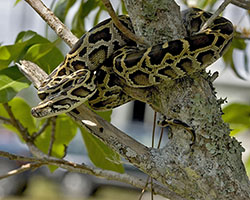Thermoregulation

When you forget to take a sweater outside at night or get stuck standing in the sun, you quickly realize how much temperature can affect your body. All animals have to keep their bodies at the right temperature. We call this thermoregulation. If body temperature gets too low or too high, an animal can get sick or even die. This is true for people too, which is why your mom or dad might always tell you to “take a sweater!” if it’s cold outside.
Thermoregulation is the control of body temperatures. Animals are classified into two main thermoregulating types: endothermic and ectothermic.
Endotherms (endo- means "within" and -therm means "heat"), such as humans, other mammals, and birds, create their own heat. This enables many of them to live in a broad range of environments, including extremely cold areas. Other animals called ectotherms (ecto- means "external") rely on the surrounding environment to control their temperature. These are animals that are often referred to as "cold-blooded," though that term definitely isn't true. There are many times that some "cold-blooded" animals regulate their body (and blood) at much higher temperatures than we do.
Whether an endotherm or an ectotherm, some behaviors related to thermoregulation are common. To cool off, animals can try to find a cool place. For example, if you are at the beach or a pool, when you get too hot, getting into the shade or the water will cool you off. Some animals can also lose heat through evaporation, which is the change of water from liquid to gas. For example, sweating and panting allows animals to cool off by dumping the heat into water that is then evaporated into the air.

To warm up, animals can try to find a warm or sheltered place. For example, they may move into the sun or find an underground burrow to get away from cold wind. Some animals shiver to warm up. Shivering uses heat produced by moving your muscles to warm the body.
Pythons are really interesting thermoregulators because they are ectotherms, like other reptiles, however, there are some species that can shiver. This behavior is a bit odd for most ectotherms, but it enables some pythons to produce a bit of their own heat. Shivering might occur in a python mom trying to warm up her eggs, as temperature is important to proper development.
How Life Deals with the Cold
Shivering snakes may seem odd, but for humans and other animals shivering is one method they use to help to keep warm. What are some of the other ways animals cope with the cold? We asked some of our experts to share a few interesting ways living things deal with the cold.
Life in the Cold - The Movie
Additional images via Wikimedia Commons. Basking Agama by Manidip1995.
Read more about: Perfect Python Parenting
Bibliographic details:
- Article: Thermoregulation
- Author(s): Dr. Biology
- Publisher: Arizona State University School of Life Sciences Ask A Biologist
- Site name: ASU - Ask A Biologist
- Date published: 20 Feb, 2012
- Date accessed:
- Link: https://askabiologist.asu.edu/thermoregulation
APA Style
Dr. Biology. (Mon, 02/20/2012 - 13:00). Thermoregulation. ASU - Ask A Biologist. Retrieved from https://askabiologist.asu.edu/thermoregulation
Chicago Manual of Style
Dr. Biology. "Thermoregulation". ASU - Ask A Biologist. 20 Feb 2012. https://askabiologist.asu.edu/thermoregulation
Dr. Biology. "Thermoregulation". ASU - Ask A Biologist. 20 Feb 2012. ASU - Ask A Biologist, Web. https://askabiologist.asu.edu/thermoregulation
MLA 2017 Style

Spending time on a warm rock in the sun helps lizards regulate their body temperature when they're cold.
Be Part of
Ask A Biologist
By volunteering, or simply sending us feedback on the site. Scientists, teachers, writers, illustrators, and translators are all important to the program. If you are interested in helping with the website we have a Volunteers page to get the process started.



